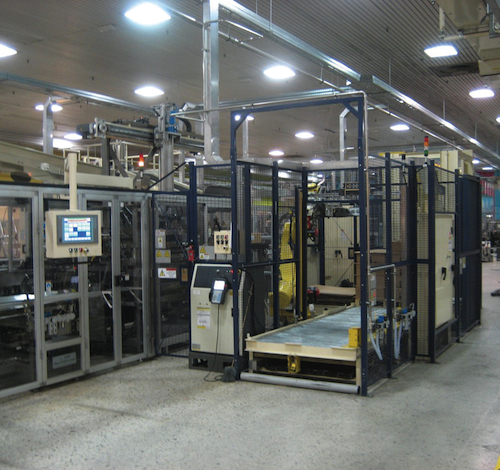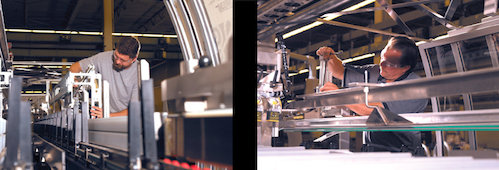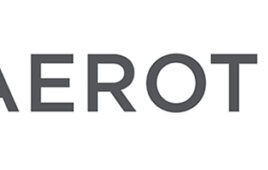When a U.K.-based spirits distiller changed to a new carton for its high-end Scotch, it turned to R.A. Jones, Covington, Ky., a builder of packaging machines and cartoners for a solution. With the help of Siemens motion control components, software and engineering support, the resulting machine was so successful that the company ordered a second version even while the first was being commissioned.

The HMI (left center) operates the cartoning line (silver and black enclosure at left), which is capable of packaging 330 bottles per minute, the result of Siemens motion control technology and R.A. Jones engineering. The enclosure at center right holds empty cardboard cases after the carton blanks are removed. (Photo credit: R.A. Jones)
One of the challenges of this project was the speed required ¾ the process needed to run at 300 bottles per minute with a 10% surge capability. The machine had to separate the incoming bottles, transfer each into an article bucket, bring the bucket into the machine, erect the carton, transfer the bottles from bucket to carton, close the carton, stand it up, then discharge it from the machine. This complex sequence had to be performed at a rate of five times per second.
Additionally, the project had stringent quality requirements. Because the product was a high-end Scotch, there was zero tolerance for any marks on the bottle, the label or the box. The customer wanted the ability to reject individual cartons, individual bottles or cartons with no bottles in them, all without derating the line. The line needed to be able to switch rapidly and easily among packaging 700 ml, 750 ml, and 1 L bottles for two premium brands.
The engineering team nominally started with R.A. Jones’ Meridian cartoner design, but instead of augmenting 80% standard platform with 20% customization, the project followed the opposite ratio.
The cartoner incorporates 27 axes powered by Siemens servomotors and Sinamics S120 drives. Although much of the machine leverages fairly standard coordinated motion, some aspects required more. So, the engineering team chose the Simotion D445, which integrates a PLC and a motion controller into a compact form factor
“The D445 works with compiled code versus assembled code, so it is faster,” said Jason Barter, application and development engineer, R.A. Jones. It provided all the processing muscle for the cartoner, allowing the team to use the S120s as passive drives.

R.A. Jones engineers installing components on the custom cartoner.
To connect the drives to the D445, the team used Siemens’ Drive CLiQ. With an Ethernet backplane based on a 100 Mb/s serial interface, the Drive CLiQ automatically captures nameplate data and validates components, simplifying device integration and replacement by maintenance staff.
Continuous operation at 300 bottles per minute required an automated carton-loading system to ensure a steady supply of packaging materials. A robotic arm from an outside vendor picks up cases of carton blanks from a pallet, inverts them, and sets them, case and all, in the magazine of the cartoner. The Jones flexbot, a two-axis pick-and-place unit powered by Siemens servo motors, lifts the case off of the stack of blanks and sets the empty case on a trash conveyor. The two-axis pick-and-place unit was controlled from the D445 controller as part of the 27 axes. The Siemens support staff developed custom function blocks for easier programming of the equipment.
With a system consisting of a 27-axis cartoner, the robotic-arm carton loader and a pallet handling system, the number of connections added up. “We had two racks of Siemens ET200S I/O on the cartoner,” said Barter. The pallet handler and de-palletizing robot formed a system by themselves. The pallet handling system was controlled by a Simotion D425, which interfaced with the robot controller over Profibus. The design team integrated the pallet handling system with the cartoner by way of a Profibus connection between the D445 and D425. “We interfaced the robot controller with the Siemens D425 controller just to get communications back and forth and also interfaced that controller to the cartoner,” Barter continued. “We connected the D425 to the main cartoner machine controller (the D445) over Profibus, and then ultimately those two machine controllers communicated with one HMI over Ethernet.”
The finished cartoner was shipped from the R.A. Jones facility to the spirits distiller’s plant in Scotland on nine full-sized pallets packed into three freight airplanes. With its combination of hardware, software, and engineering, the machine achieved a maximum speed of 330 cartons per minute, which meets specification with the required 10% surge. “The machine is running well,” said Barter. Based on the success of the first machine, a second one was ordered.
Siemens Industry Inc.
www.usa.siemens.com
Filed Under: Packaging, Motion control • motor controls, Motors • servo





Tell Us What You Think!